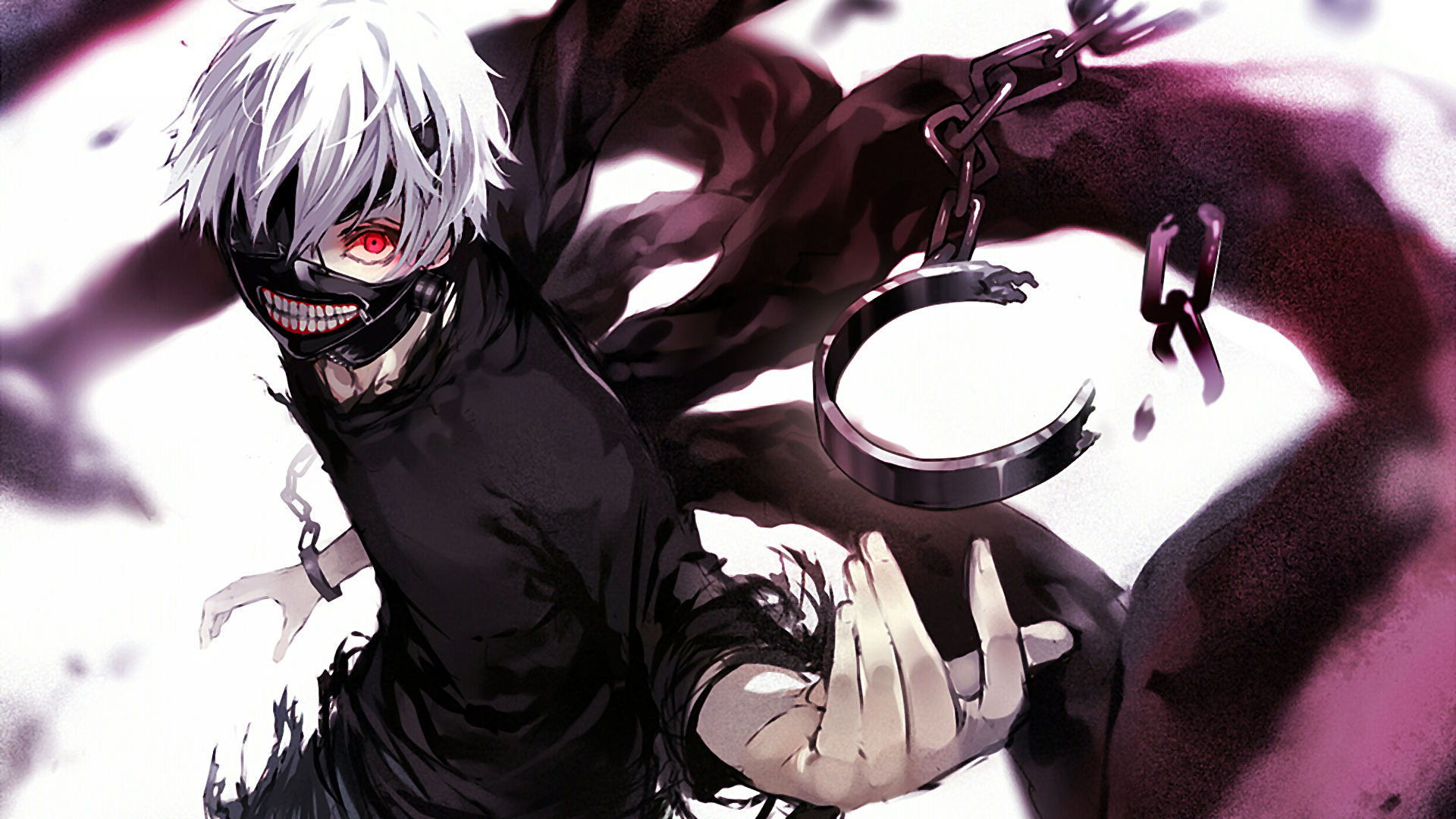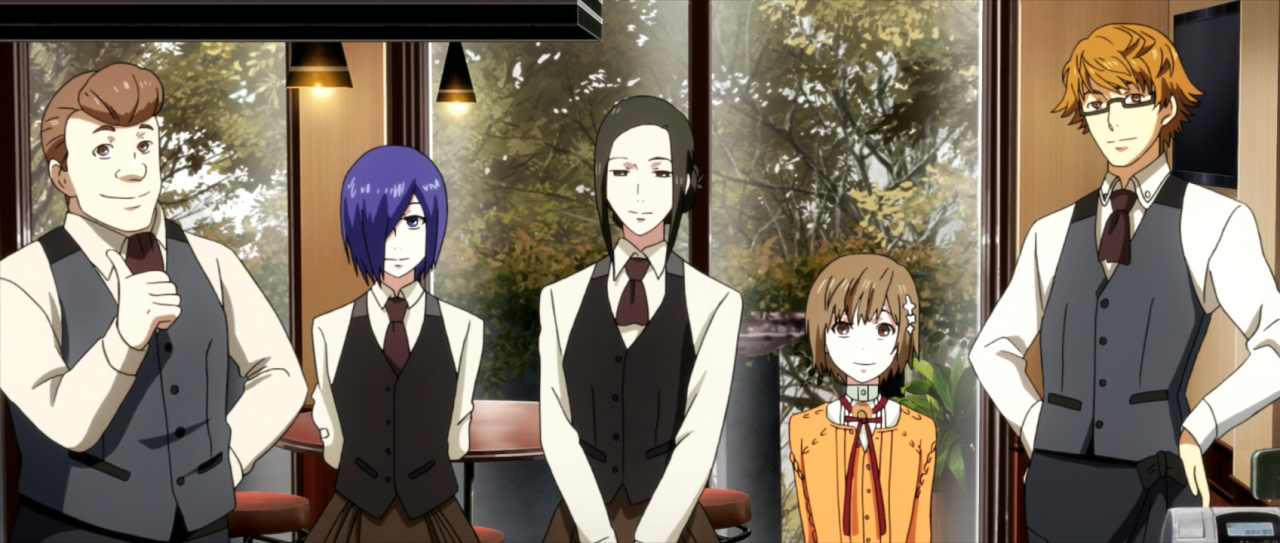Tokyo Ghoul
November 27, 2019 · 0 comments
By Andrew Osmond.
 Good news, young man; your beautiful girlfriend wants to have you for dinner. It’s an old joke (especially for fans of cannibal superstar Hannibal Lecter) but it’s a fair summary of how Tokyo Ghoul opens. It’s set in what seems to be present-day Tokyo, with a big difference; the city is infested with “Ghouls,” who usually look like ordinary people, but who secretly crave human flesh. In the opening episode, naïve university freshman Kaneki, orphan and bookworm, is smitten with a lovely young woman, even while his envious friend Hide insists she’s out of his league. After a great date, the gentlemanly Kaneki insists on walking the lady home, down darker and darker streets. It gets intimate, one thing leads to another… and the next thing Kaneki knows, she’s biting chunks off him and rearranging his intestines.
Good news, young man; your beautiful girlfriend wants to have you for dinner. It’s an old joke (especially for fans of cannibal superstar Hannibal Lecter) but it’s a fair summary of how Tokyo Ghoul opens. It’s set in what seems to be present-day Tokyo, with a big difference; the city is infested with “Ghouls,” who usually look like ordinary people, but who secretly crave human flesh. In the opening episode, naïve university freshman Kaneki, orphan and bookworm, is smitten with a lovely young woman, even while his envious friend Hide insists she’s out of his league. After a great date, the gentlemanly Kaneki insists on walking the lady home, down darker and darker streets. It gets intimate, one thing leads to another… and the next thing Kaneki knows, she’s biting chunks off him and rearranging his intestines.
Luckily for Kaneki, the woman is suddenly crushed under a falling steel beam (though it’s not the last he’ll see of her). It’s debatable, though, if what happens next is good or bad luck. Rushed to hospital, the dying Kaneki is saved by an organ transplant, and no prizes for guessing who the donor is. Afterwards, Kaneki finds himself incapable of eating any food, and starts getting scarily hungry as he eyes the Tokyo crowds (the show’s most grimly funny scene). A physical transformation follows: Kaneki’s left eye becomes a grotesque crimson spider web. Then a tasty smell leads him back into the dark streets, and into the secret world of the Ghouls.
Based on a manga by Sui Ishida, Tokyo Ghoul represents a striking departure into horror for the venerable Pierrot studio, best known for the mega-franchises Naruto and Bleach. But like many horror monsters, Tokyo Ghoul is a skilled mimic. In its realistic contemporary backdrops, the show recalls the work of Studio Madhouse on one of anime’s great dark hits, Death Note. An example of those settings: Kaneki’s ill-fated walk with his girlfriend takes them through a very recognisable Omotesando Hills, a chic Tokyo shopping area near Harajuku. And Pierrot doesn’t pull punches because it’s associated with family fare; quite the reverse! Ghoul’s gory enough in the early episodes, but its finale is so punishingly, gruesomely gruelling that even movie torturers Eli Roth and Takashi Miike might think it goes a bit far.
That’s not to say Tokyo Ghoul is all splatter and torture, though. It mixes bits and pieces from across the map, some of them very recognisable. Let’s start with the ghouls. They’ll strike most viewers as somewhere between zombies and vampires; they crave human flesh, but have human-like intelligence and speech. A big difference between ghouls and their relatives, though, is that they don’t seem to be humans “turned” into monsters; where they come from is a mystery. Kaneki, trapped between the human and ghoul worlds, realises his existence might have many implications in the struggle between the species. That he gets a ghoul’s organs through a transplant puts him in the tradition of the Japanese hero Ultraman, a symbiont of human and alien, and characters such as the half-monster women in Claymore and the “talk to the hand!” heroes of Parasyte and Vampire Hunter D.
One of the strongest elements of Ghoul is its emphasis on the craving for food, often with openly sexual connotations, its carnal mix of lust and disgust. One of the most memorable scenes, in Ghoul’s first episode, is of Kaneki trying frantically to eat any “normal” food, and heaving helplessly over and again. Luckily – slight spoiler – there turns out to be a loophole for ethically-minded ghouls who can’t treat humans the way humans treat cattle. Ghouls are okay eating already-dead bodies, and find a ready food supply at Japan’s suicide spots. It’s a solution which you could argue (morbidly) is very Japanese, though you could imagine British ghouls camping near Beachy Head for the same reason.
 Kaneki is fortunate enough to find such “ethical” ghouls, led by a gently fatherly old man called Yoshimura (reassuringly voiced in Japanese by Takayuki Sugo, who was Bleach’s weapon Zangetsu). Thanks to him, Kaneki finds a home – an ostensibly ordinary Tokyo coffee shop called “Anteiku,” which happens to be where the lad had that date in the first place. Kaneki also finds a surrogate family of benign ghouls, including a close-bonded mother and her young daughter who prove important to the plot. This mother and child might possibly be a joke at horror fans’ expectations; one of the most notorious scenes (NSFW) in the zombie classic, Romero’s Night of the Living Dead (1968), was of a zombie girl killing and eating her mother.
Kaneki is fortunate enough to find such “ethical” ghouls, led by a gently fatherly old man called Yoshimura (reassuringly voiced in Japanese by Takayuki Sugo, who was Bleach’s weapon Zangetsu). Thanks to him, Kaneki finds a home – an ostensibly ordinary Tokyo coffee shop called “Anteiku,” which happens to be where the lad had that date in the first place. Kaneki also finds a surrogate family of benign ghouls, including a close-bonded mother and her young daughter who prove important to the plot. This mother and child might possibly be a joke at horror fans’ expectations; one of the most notorious scenes (NSFW) in the zombie classic, Romero’s Night of the Living Dead (1968), was of a zombie girl killing and eating her mother.
Ghoul’s other characters include, naturally, an attractive ghoul girl of Kaneki’s age, called Toka (she’s voiced by Sora Amamiya, who was an android girl, Ilsa, in the recent Plastic Memories). With Toka as the angry adolescent – she beats Kaneki up, with a disturbing level of gusto – and Kaneki as the kindly, passive type, the show seems headed down a predictable anime arc, except… Well, watch the show! The shock developments later on seem to deliberately troll our expectations… and given Kaneki turns out to have mother issues, and spends a lot of time screaming in a chair, one suspects someone saw Evangelion and decided it was time to really take it out on a Shinji substitute.
But then Tokyo Ghoul invites comparison with a whole spectrum of anime. Both the ghouls and humans fight using paranormal forces which they shape into weapons, leading to big fights in the tradition of Naruto and Bleach. Moreover, Kaneki finds that it’s not just his late girlfriend’s organs he’s ingested. Throughout the show, he’s taunted by her dark spirit, as unwelcome as a nine-tailed fox as it psychologically dissects poor Kaneki, a la Hannibal Lecter. Then there’s a whole other side of the show which follows the police battling to take down the Ghouls; it recalls the war with Kira in Death Note. There are nifty flips in perspective between characters who see each other as hideous, brutal monsters. In another break with horror tradition, Ghoul starts with the public already aware of the existence of Ghouls, whose eating habits are discussed on TV.
It’s also worth noting that Tokyo Ghoul was broadcast in Japan almost the same time as Parasyte: The Maxim, Madhouse’s version of the Parasyte horror manga by Hitoshi Iwaaki, where aliens turn people into toothy nightmares. In the early episodes, Ghoul and Parasyte have an impressively long list of parallels, even if they diverge as the shows go on. Most obviously, both force their teen heroes to be real outsiders, cut off from the rest of humanity by the terrifying changes to their bodies and minds. Iwaaki’s original manga dates back to 1988, so it’s possible that it was an influence on Ishida’s strip.
Either way, Ghoul’s first season ends with the anime — much like Kaneki — establishing a very definite identity, even as it slides between coffee-shop drama, Bleach-ish action and serious splatter.
Andrew Osmond is the author of 100 Animated Feature Films. Tokyo Ghoul is released on UK blu-ray by Anime Limited, and is streaming now on Channel 4’s All4 service.
Leave a Reply